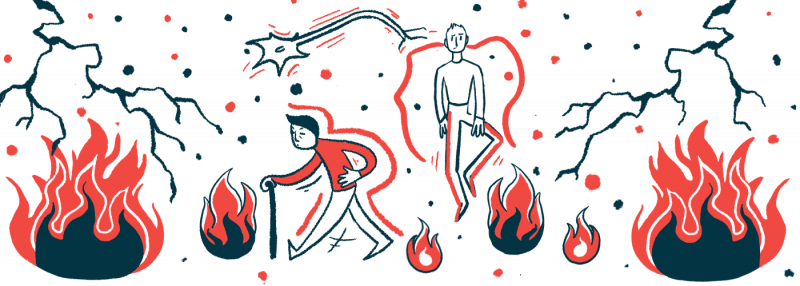 Pain and Multiple Sclerosis Up to two-thirds of people with multiple sclerosis (MS) experience a wide range of pain-related symptoms, from headaches and back pain to painful tonic spasms (cramping and pulling pain) and continual burning pain in the extremities. MS-related pain can be acute (temporary) or chronic (extended duration), and can be further categorized as primary and secondary depending on whether it stems directly from damage to the central nervous system, or results more indirectly from other MS symptoms and stresses. Neuropathic pain, where the sensation of pain is caused by damage to the parts of the nervous system normally responsible for detecting pain, is a primary pain syndrome and is the most common type of pain experienced by people with MS. Musculoskeletal pain is a secondary pain syndrome that occurs as a result of abnormal muscle activity like spasticity in MS patients. Cramping and stiffening in the limbs can strike without warning and affect muscle groups or the entire body. |
|---|
Some types of neuropathic pain that MS patients may experience include:Trigeminal neuralgia: the term used for facial pain associated with damage to the trigeminal nerve, or the fifth cranial nerve — the largest one among the body’s 12 pairs of cranial nerves and one of the most widely distributed nerves in the head. Dysesthesia: the altered, unpleasant and possibly painful sensations that MS patients can experience, frequently described as a burning and aching feeling or, if affecting the trunk, a “girdling” sensation across the body (popularly known as the “MS hug”). Optic neuritis: results from inflammation of the optic nerve, the nerve that transmits information from the eyes to the brain, or from lesions that form along nerve pathways responsible for eye movement and visual coordination. Erythromelalgia: an intense burning sensation that typically affects the feet or hands, accompanied by skin that may look reddish and feel hot to the touch. |
|---|
 Did You Know? A 2021 study suggests that symptoms including sleep disorders and pain may precede the onset of the more well-known symptoms of MS by as many as five years. Understanding these first symptoms could aid in an early diagnosis, allowing treatment to begin at initial stages of disease. |
|---|
“My pain and illnesses have changed me. Both pain and suffering have fortified me to walk in my truth and share my story. It has made me uncomfortably comfortable. What a conundrum! My truth is not always pretty. It does not come wrapped in a decorated package. At times, it is a tangled, mangled mess and I can say that I am OK with that. Would I choose this? Of course not. Yet, my greatest lessons have been learned in the throes of illness.”— Theresa Wright-Johnson, columnist, “Patiently Awakened” |
|---|
 Did You Know? In 2019, researchers at the University of Michigan investigated in detail the mechanisms behind chronic mechanical itch, looking for possible treatment approaches. By studying this effect in mice, they found that the nerve cell circuit, stretching from the skin to the spinal cord, is likely responsible for the persistent itching sensation that can affect people with MS. |
|---|
“Ache, twitch, kick. Ache, twitch, kick. It is a reminder that my body is not my own. As if on cue with this epiphany, I begin to cry. I am burdened by fatigue. I am weary. Yet three hours later, the rhythm continues. … For those with MS, restless legs syndrome (RLS), the uncontrollable urge to move one’s arms or legs, is a nightmare. While it usually begins in the evening, I have RLS attacks all day.”— Jennifer Powell, columnist, “Silver Linings” |
|---|
 Describing Pain People with MS experience pain more often than what was once thought by clinicians, but they often have trouble identifying and describing the pain they experience, possibly because the sensations they are feeling can vary enormously. This difficulty can serve as a barrier to managing pain. Patients best able to effectively describe the nature of the pain they are experiencing are most likely to find a way to treat or ease it; at the same time, doctors need also be aware that pain is a very real symptom of MS and they should not disregard patient complaints. Commonly described types of MS-related pain range from uncomfortably cold or hot sensations and pins and needles, to a stabbing sensation similar to an electric shock, or a burning or aching sensation often around the legs or trunk. |
|---|
Our patient columnists describe some of the pain they experience:
“It took two years and many doctors to finally receive my MS diagnosis. Frequent painful sensations, such as burning, itching, stabbing, and tingling in my arm and shoulder, led my providers and me on a wild-goose chase in search of other problems. When my speech and balance were affected, I finally received an MRI of my brain, rather than my shoulder. I was told that MS didn’t usually cause pain.”
— Judy Lynn, “You’ve Got Some Nerves”
“Sometimes the nerve pain caused by MS reminds me of a pinball machine. With the slap of the paddles the ball surges, bouncing sporadically, bells ringing, lights flashing; then the ball quietly comes to a stop and all of the commotion is silenced until the next slap. The sharp and extremely uncomfortable nerve pains I experience are very similar to a game of pinball. They begin quickly, run their havoc and then they are gone (if I am lucky) in a flash.”
— Debi Wilson, “Faith of the Mustard Seed”
“Suddenly, I’ve developed pain in both hips and I don’t know why. The pain is most intense when I first put my feet on the ground, either getting out of bed in the morning or sliding off a wooden stool to a standing position after breakfast in the kitchen. It’s worse if I’m standing or walking on a hard surface, such as tile, and in bare feet. It’s less intense as I walk, using my two canes. And it’s hard to notice it at all, right now, as I’m writing this sitting at my desk on a comfortable leather chair, feet on the ground with good back support.”
— Ed Tobias, “MS Wire”
“My trigeminal neuralgia is very specific. It attacks one of the molars on my lower left jaw. When it first began happening, it was like an electric fire in my tongue. Eventually, it settled into one tooth. I sometimes get a warning of an impending attack if I feel slight pain when my tongue happens to rove in that direction. This time, I was composing a voice message on my phone when it hit full-bore.” Think of the worst drilling pain you’ve ever experienced at the dentist’s office and multiply it by 10.”
— John Connor, “Fall Down, Get Up Again”
 Did You Know? From a clinical standpoint, the prevalence of pain in people with MS varies widely and is likely underdiagnosed in these patients. In one study from 2017, researchers in Italy found that more than half of the 374 MS patients who were analyzed had chronic pain, most notably neuropathic pain. Their results indicate that pain is underdiagnosed and undertreated in MS patients, and a factor that may contribute to increased disability. |
|---|
“Dear Doctor,Why is it that you, or at least some of your colleagues, think that multiple sclerosis isn’t painful? Did you skip the med school class where they discussed MS? Are you not a neurologist, or are you a neurologist who doesn’t specialize in MS? Whatever the reason, this ‘MS doesn’t cause pain’ belief can be a significant problem for many of us living with the disease.”— Ed Tobias, columnist, “MS Wire” |
|---|
 Did You Know? A class of molecules called positive allosteric modulators, or PAMs, may be useful in treating pain caused by nerve damage in MS patients, according to a 2021 study that shed light on how these molecules work. The researchers say their findings highlight the potential of these PAMs to serve as a non-opioid alternative for the management of chronic pain. |
|---|
“Daily chronic pain affects my mood, sleep, relationships, and overall quality of life. And some days are insufferable. But I am not suffering. I work very hard at managing my multidimensional relationship with pain.While I take pain medications, they are not a panacea. Medications afford me the ability to try other modalities. Meditation, guided imagery, cognitive therapy, heating pads, ice packs, and yoga are collaborative tools. No two days are alike. The tools I use vary with my need.”— Jennifer Powell |
|---|


